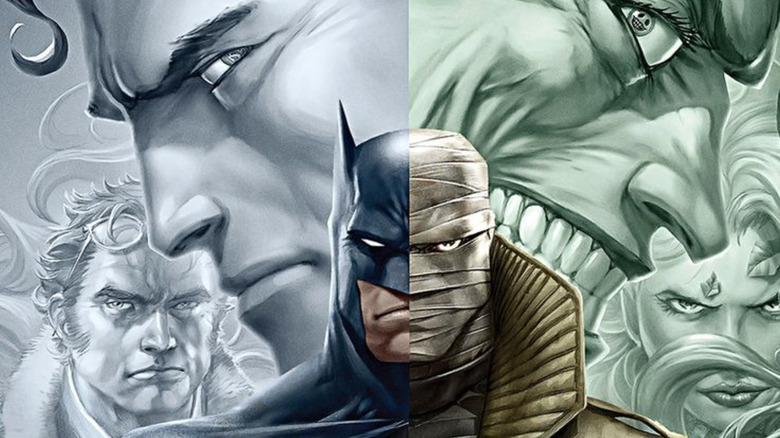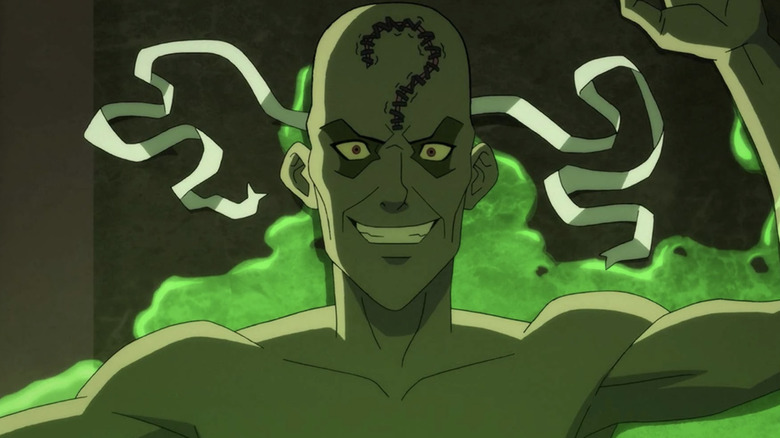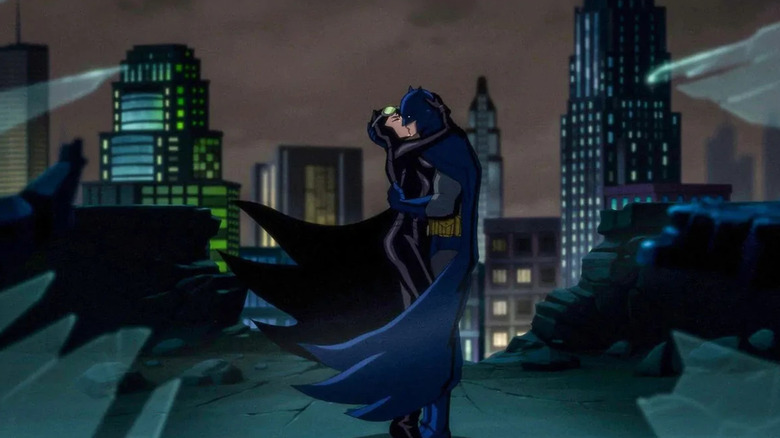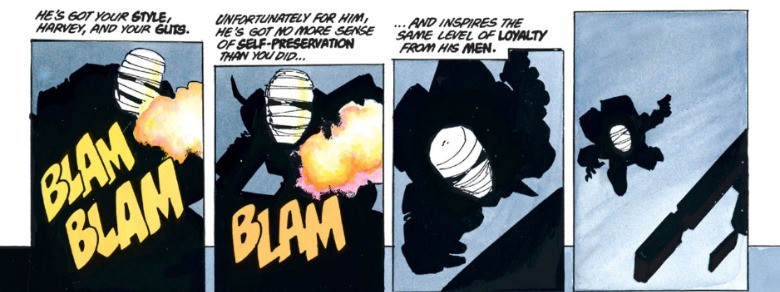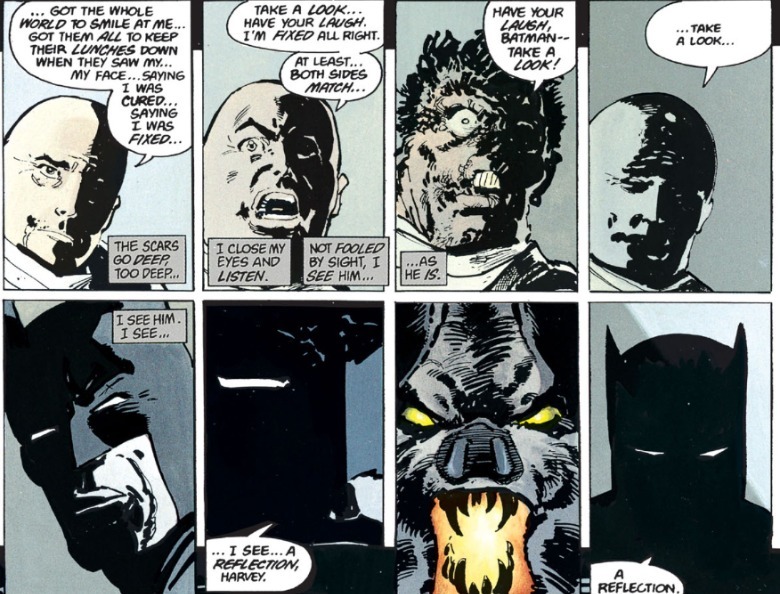Why The Animated Batman: Hush Changed The Identity Of The Comic's Villain
Jeph Loeb and Jim Lee's 2002 "Batman" story arc "Hush" is in the hall of canonical Batman stories, so it was only a matter of time before it got a movie — and it did, in 2019, via the animated "Batman: Hush." But not every Bat-fan out there appreciated the changes the movie made.
One reason "Hush" has stayed popular is because it's self-contained, accessible, and includes lots of important faces. Chapters Four and Five even detour to Metropolis so Batman can meet up with, and fight, Superman. This makes "Hush" a great first "Batman" comic to recommend to new readers. The memories for "Hush" are so fond that DC has even roped Loeb and Lee back in for a "Hush" sequel, which is ongoing in "Batman" right now.
"Hush" has the same structure as Loeb's even more acclaimed "Batman: The Long Halloween" (drawn by the late Tim Sale) — an episodic story of Batman fighting his major enemies, tied together by a mystery villain.
In "The Long Halloween," that is Holiday, a serial killer that whacks members of the Gotham mob on holidays. In "Hush," it's the titular mystery man in a bandage mask and trench coat. Hush, who wants to keep his identity exactly that, has roped in all of Gotham City's A-list villains to help him take down Batman.
In the original "Hush" comic, Hush was Dr. Thomas Elliot, a newly-introduced character. One of Bruce Wayne's childhood friends, Mr. Elliot grew up to be a surgeon (hence the bandage motif with Hush). He's framed as a mirror image of the orphaned Bruce Wayne; as a child, Tommy cut his parents' car brakes so he could get freedom and their wealth. Bruce's father, Dr. Thomas Wayne, saved Elliot's mother. For the "sin" of his father, Elliot wants revenge on Bruce.
"Batman: Hush" the movie did something different — this Hush was a rebranded Riddler (Geoffrey Arend). In the movie, Thomas Elliot (Maury Sterling) was what he first appeared to be; Bruce's friend, who became another innocent soul who Batman couldn't save.
In "Hush" (both versions), Edward Ngyma developed brain cancer. So, he snuck into a Lazarus Pit, where the pit's power cured his disease and gave him enough clarity to piece together that Bruce Wayne is Batman. In the movie, Riddler then set out to get revenge on both Batman and Elliot for failing to surgically treat his cancer. He became "Hush" because he was a joke as the Riddler; only a new name could make him feared.
Lots of Batman fans were baffled by this change; why so drastically change the story you were adapting? "Hush" screenwriter Ernie Altbacker said he decided to keep the mystery of the story intact by coming up with a different answer to it.
Batman: Hush changed Hush from Thomas Elliott into the Riddler
Like any good mystery, "Batman: Hush" has a fair share of red herrings. Thomas Elliot himself is a double one. His return to Bruce's life coincides with Hush's scheme, so you're meant to suspect he's Hush from the beginning. Then, he seemingly dies halfway through the story, throwing a wrench in the suspect list until the end.
(In the comic, Elliot was faking his death by having Clayface pose as his corpse. In the movie, Elliot's death is real, but the movie also repurposes the shapeshifting twist by having Clayface pose as the Riddler instead.)
In "Hush" Chapter 10 the villain is seemingly unmasked as the second Robin Jason Todd, back from the dead after being murdered by the Joker years prior. (Again, this was actually Clayface.)
At San Diego Comic-Con 2019, Altbacker discussed his main challenge with adapting "Hush" — turning a 12-issue story into a 70 minute movie. As he considered what to cut and what to keep, he thought about how to reinterpret "Hush."
"In the story [of 'Hush'], there are a lot of kind of red herrings, and I was like, 'What if one of these red herrings was the way we go?' and we can totally fake out the fans. By making a couple of those choices, some scenes fell out and it became a little easier to produce."
That is the cleverness of the twist. When you've read a book before watching its movie adaptation, you know how the story will go. For mystery stories, that can sap some of the fun. "Batman: Hush" turned fans' knowledge of the source material itself into a red herring — the movie knows you expect Thomas Elliot to be Hush, so it uses him as a triple red herring. (Hush, like Elliot, is voiced by Maury Sterling and the Riddler's true voice only comes through when he's unmasked.)
The twist isn't completely unfaithful to the comic, either. The final twist of the original "Hush" story is that while Thomas Elliot was Hush, he got a lot of help from the Riddler. As the movie faithfully depicts, the Riddler learned Batman's identity during his Lazarus Pit bath. In the comic, Riddler partnered with Hush, while in the movie, the Riddler became Hush.
2022's "The Batman" takes most of its inspirations from Loeb's Batman stories, both "Long Halloween" and "Hush," down to being a Bat-Cat romance and a murder mystery. In that movie, the killer is the Riddler (Paul Dano), and it too feels like it spiritually merged Eddie Nygma with Hush.
Does the animated Batman: Hush pass or fail as an adaptation?
Though in the minority, I don't mind the movie making the Riddler into Hush, because I never found Thomas Elliot as Hush to be a satisfying answer in the comic. The whole point of Hush is he's someone intimately familiar and obsessed with Batman, so inventing a new character to fill that role left little impact. Plus, even in the comic, Riddler is the real mastermind, so the movie's twist is more faithful to the source material than you might think.
Now, where the movie falls shorter is the Riddler's fate. In the comic, despite the Riddler knowing Batman's true identity, he still loses. As Batman's deduces, Riddler's compulsions will keep him from ever spilling the truth; he can't reveal Batman's identity, because what good is a riddle if everyone knows the answer to it? In the movie, Riddler falls to his death into a pool of molten metal; Batman (Jason O'Mara) tries to save him, but Catwoman (Jennifer Morrison) lets him fall. Both the original and adaptation end with them splitting up, but in the movie, Riddler's death is the breaking point.
Since "The Long Halloween," Loeb focused a lot on Bruce Wayne and Selina Kyle's romance. "Hush" builds on that, as Batman slowly lets himself trust Catwoman, while Selina realizes the two men she's in love with are the same person. In "Batman" #615, Batman takes off his mask and shares all of himself with Selina: "I have two halves. I want you to be part of both of them."
The animated "Hush" rightfully understands that Batman and Catwoman's complicated love is the core of the story. For all the film cuts, everything about that relationship is kept. But like Batman and Catwoman, "Hush" (and Loeb's whole Batman saga) has two hearts, and the film completely leaves out the other one.
That would be Harvey Dent/Two-Face. Though the absence of Tim Sale muddies the connection a bit, "Hush" is a spiritual sequel to "The Long Halloween." That comic is all about Dent's downfall; how he goes from Gotham District Attorney and Batman's ally to becoming one of the city's super-villain "freaks." "Hush" is Harvey's redemption; Elliot uses his plastic surgery skills to fix Harvey's scarred face, and that heals his mental scars too. In the final chapter of "Hush," it's Harvey who saves Batman and defeats Elliot. Batman muses he's lost one friend, but may have regained another.
Hush's bandaged look, too, evokes Two-Face's design from the most influential Batman comic ever, Frank Miller's "The Dark Knight Returns."
Hush is one many villains designed as a mirror image of Batman, but no villain fills that role quite as well as Two-Face does.
"The Dark Knight Returns" suggested that not even surgery to heal Two-Face's appearance would tame his bad side. "Hush," though, builds on the heroic and determined Harvey Dent we met throughout "The Long Halloween." Dent's story there was a tragedy, while "Hush" ends with hope for him.
The animated "Batman: Hush" understands the comic is a Catwoman and Riddler-centric story, but forgot it's also a Two-Face one.
